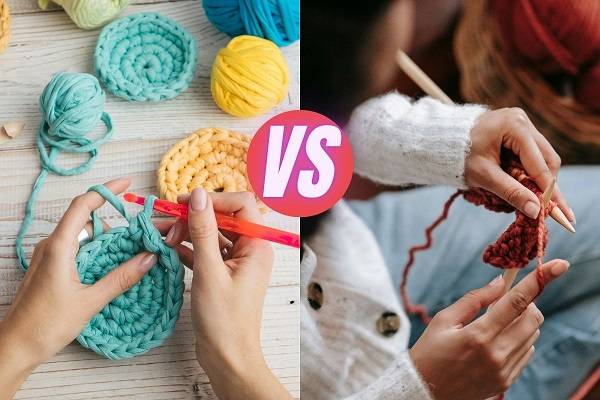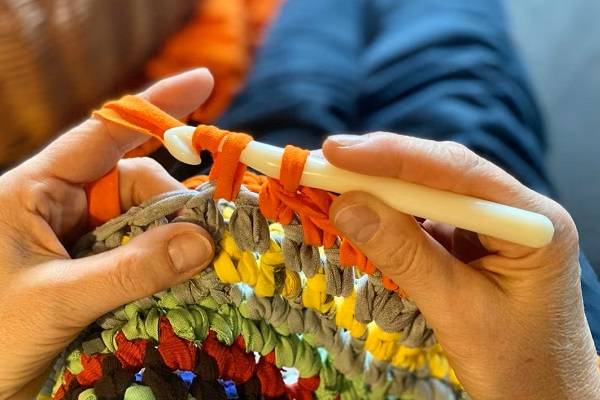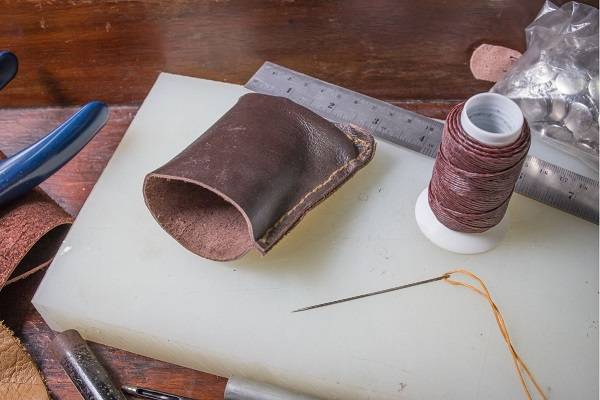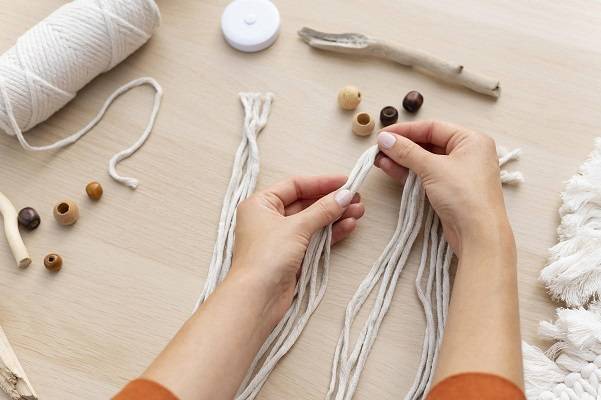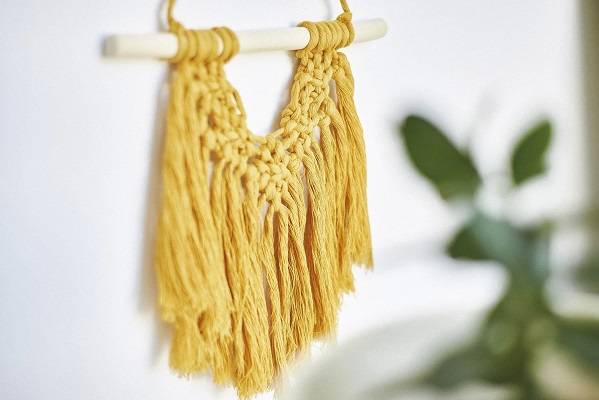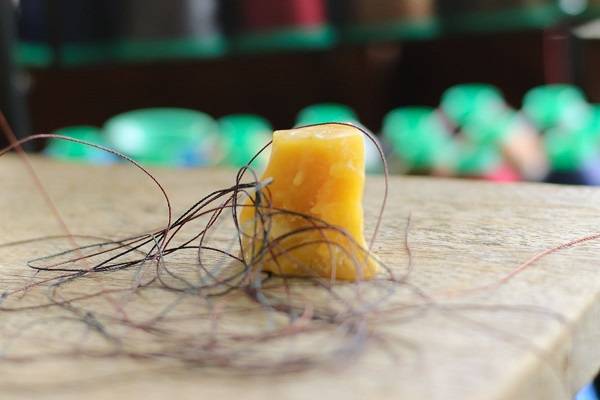WEAVING TUTORIAL
Weaving for Beginners: A Step-by-Step Guide to Mastering the Craft
Learn How Does Weaving Works, Understand the Techniques, Origins, Looms and Where to Find Best Yarn for Your First Project

Innovation & Quality
Developing and supplying premium-quality, sustainably grown, consumer products
100% Natural
Organically Grown and Ethically Sourced
hemp and other natural fiber products
Shipping
We offer fast shipping
Your order out within 1-3 days
Wholesale
Visit our wholesale portal to register or login to your account
Weaving is a traditional craft that has been practiced for thousands of years. Throughout history, humans have used this technique to create baskets, clothing, tapestries, rugs, kilims, woven home textiles, wall hangings, apparel, etc. If you are thinking of starting to practice this traditional craft, you have come to the right place. We have created a guide for beginners like you which will introduce you to the magic of weaving and help you learn the basics of creating woven masterpieces.
Shop Premium Weaving Yarn at Hemptique!
Hemptique manufactures a selection of first-class weaving yarns and other fiber supplies, perfect for both beginner and advanced crafters. The fibers are made from natural materials, offering eco-friendly and sustainable alternatives for hobbyists all over the world. Committing to the highest standards of excellence and eco-consciousness, we created top-quality weaving yarns such as 2-pack hemp yarn, Premium linen cord , Premium linen cord with soy wax coating , Natural yarn balls , and Hemp yarn bon bons . They come in a variety of sizes, thicknesses, and colors, and are suitable for any project, whether it’s basic or intricate. Choose our quality fibers to ensure your tapestries, wall hangings, scarves, rugs, and coasters are durable, strong, and last a long time. For custom orders and volume pricing benefits, send us a bulk/large quantity request or apply for a wholesale account.
What Is Weaving?
Weaving is a crafting technique of making woven textile using yarn. You can weave a variety of fabrics, from clothing to home textiles and DIY items. Using some thread and a loom you can make blankets, pillowcases, baskets, towels, shawls, table runners, placemats, bookmarks, Christmas decorations, lamp shades, and even jewelry. It is different from other textile arts like crocheting, knitting, and macrame because it requires a loom.
Origins and Weaving Through History
Weaving is one of the oldest crafts in the history of humans. From Ancient Egypt and Mexico to Persia, there is evidence of textile industry remains that date back to the prehistoric period of Stone Age. It is believed that wool was the first material used for this art form.
The first traces of woven textiles originate from Peru, between 10,000 and 9080 BCE. Another fragment of woven hemp cloth was found in Anatolia, Türkiye, dating back to approximately 7000 BCE. As you can see, weaving was present throughout the ages. Before the Industrial Revolution, it was a manual craft made mainly with wool. With the Industrial Revolution, power looms took over handlooms and enabled more efficient fabric production.
Weaving Terminology
To master the art of weaving beautiful textiles, start with learning the terms and unique slang. It will help you understand the patterns and techniques much better, and you will be able to improve your skills faster. The list below contains several basic terms found in weaving.
- Warp – One of the basic components in weaving. Warp is vertical stationery yarn (or thread) stretched in tension on the loom. Since it acts as foundation for your weaving and is held under high tension, the fiber must be very strong, such as hemp or linen. The horizontal yarn passes over and under the warp to form fabric.
- Weft – Also referred to as a ‘woof’, weft is yarn that is woven horizontally between the warp threads. It creates the desired pattern of your fabric.
- EPI (Ends per inch) – EPI is the number of warps per every inch of your weaving. A larger EPI means that there is less space between the warps and results in tighter design, while smaller EPI mostly results in tapestry (weft-faced) weaving.
- Shuttle – A spindle shaped tool that stores weft yarn and makes the weaving process simpler on your hands. Shuttle can either be thrown or passed through the warp to make the textile.
- Loom – A structure that gives you support as you work. It’s a device that holds the warp yarn under tension while other threads are woven through them crosswise.
- Weft-faced – A type of textile where the weft covers the warp entirely.
- Warp-faced – In this type of interlacing, the warp threads are visible, and weft ones are not.
- Selvedge – Finished left and right edges on the sides of your woven piece.

Types of Weaving: Basic Techniques
The pattern and look of finished fabric depend on how you interlace warp and weft. Keep in mind that different structures and different techniques also have different properties. One technique may give you a fabric with better draping, while the other may result in denser and tighter weave.
Plain weave

Most people think of this structure when they think of weaving. Also called ‘tabby’, this simple technique involves weaving the weft (horizontal yarn) over warp (vertical) and then under it, and this is the whole pattern. The warp and weft cross at right angles creating a strong, cris-cross pattern. If your pattern is not image-based, it will look the same on the front and back.
- Balanced weave – a balanced amount of warp and weft
- Tapestry weave – weft-faced fabric made using discontinuous weft (multiple weft bundles) that’s not relying on repetition.
Twill weave technique

This is one of the most commonly used techniques. Twill weave is done by passing the weft over and then under several warps at a time, in an alternating pattern. This type of technique creates diagonal lines, or ribs, and it is ideal for crafting strong, high-density textiles.
Satin weave

In this technique, the weft is passed over 3 or more warps, and then under one before repeating the pattern. This technique is mostly used for making soft and smooth textiles that drape really well. Beware that satin textiles tend to snag. There are two different types of this technique – satin (warp-faced) and sateen (weft-faced).
Weaving Essential Tools & Supplies
Before you embark on a journey of weaving, you will need to acquire essential tools and supplies. Here’s what’s typically used in weaving:
- Loom –There are many different types of loom on the market - simple frame (lap) looms suitable for beginner crafters, rigid heddle looms, table looms, backstrap looms, inkle looms, floor looms, etc.
- Shuttle – The simplest one is in the shape of stick, which is mostly used on table looms and is passed from one hand to the other. Other varieties include belt shuttles, boat shuttles, end-delivery shuttles, ski shuttles, etc.
- Yarn – You will need two types of yarn – one for the warp, and the other for the weft. The one used for the warp should be strong and durable like waxed linen cord, while you can use any size or thickness thread for the weft. This hemp yarn bon bon set comes in set of 6 different colors.
- Shed stick - Wooden tool that looks like a paint stirrer. It is used to maintain warp cross, provide strong base on which you can press your fabric down, and keeps your pattern neat and straight. When searching for shed stick, make sure that it is longer than the warp, ideally by 1” – 2”. You can either purchase it at specialty craft stores, or simply use an item like a ruler, a wooden dowel rod, or a piece of cardboard.
- Tapestry needle – Use straight or bent needle with wide eye to weave weft into the loom.
- Scissors – You will also need sharp fabric scissors to cut fiber with precision so that the end product looks neat.
- Weaving comb – A tool used to press weft yarn down, adjust the density and push the completed row snuggly and neatly against the previous row.
How To Choose the Best Yarn For Weaving?
A good yarn should be durable, and strong, especially if it is used as warp. On the other hand, werf thread may be softer and more flexible, as it is the one that will be manipulated. Considering there’s a huge number of yarns available, it can be challenging to choose the right one for your specific craft. And if you want to find the absolute best, you should take into consideration several important factors:
- Project type – For weft-faced projects (tapestry, rugs, thick mats, shawls, tote bags, etc.) opt for fibers that are suitable to be held at high tension. If you are crafting home textiles, you will want to choose softer fibers, that are still sturdy enough to withstand continuous use (linen, hemp, cotton). Make sure the materials can be washed if needed. Wool and other drapey yarn is preferred for softer garments like scarves and shawls.
- Your skill level – If you are novice weaver, opt for materials that are easy to unravel and gentle on your hands.
- Yarn strength – Consider hemp, linen, or nylon as the strongest options on the market.
- Weight - Worsted weight yarn is great choice for beginners because it is easy to see the pattern, which is not always the case with smaller alternatives. Plus, it’s great option for good weft in tapestry. Bulkier versions are suitable for larger items with lots of texture.
- Other factors – You should also consider the color you need, availability of product, the cost, fiber contents, and other features that might impact the final product.

Recommended Yarn for Your First Project
2-pack Hemp Yarn

Sold in packs of 2 balls, this premium yarn is excellent for weaving as it is gentle on your hands, yet strong enough to hold the necessary tension. The blend of natural materials (hemp and cotton) has exceptional features such as strength, durability, flexibility, and mold resistance. The reason why it is popular among weaving artists is because it allows you to create any design with ease, from simple, beginner’s patterns to the most intricate ones, intended for experienced crafters.
- Material: Cotton (65%), Hemp (35%)
- Length: 66yds (60m) x 2 Total: 132 Yards
- Size: 1.75oz (50g)
- Colors: Mint, Periwinkle, Sky Blue, Natural, Dusty Pink & Moss Green
Premium Linen Cord

Linen (flax) cord is high-quality, eco-friendly fiber made of flax plant. It is ideal for weaving, but also for numerous other crafts like macrame, crochet, knitting, tapestry making, etc. Its incredible properties include high tensile strength, abrasion resistance, moisture absorption, and many others. In fact, its remarkable durability makes it suitable to be used as a warp in weaving.
- Material: 100% non-fraying, first class Egyptian flax linen
- Thickness: #48 (1.75mm) 12ply, #20 (1mm) 4ply, #10 (0.5mm) 2ply
- Length: 205 ft (62.5m)
- Color: Natural
Hemp Yarn Bon Bons

Hemp yarn bon bons are known for their fantastic durability and natural resilience to mold, rot, and UV lights. Since hemp is also hypoallergenic and toxic-free, it is safe for use even for kids. Hemptique bonbons are offered in five color variations, and each set has six yarn balls.
- Material: hemp
- Length: 6 x 82ft (6 x 25m)
- Properties: Sustainable, eco-friendly, AZO-free, oil-free
- Colors: denim, love, crayon, earthy, nature
Types of Looms
Loom is one of the essentials that you must have if you want to start interlacing thread and create beautiful woven handicrafts. If you don’t have one, you can either make one yourself or buy it at craft stores. To choose the best loom, you will have to consider your preferences, project requirements, your skill level, space, and budget. Beginners typically start with small lap (frame) looms and gradually move on to rigid heddle loom or table loom.
- DIY loom – Can be made from a piece of wood, frame, or even cardboard, using nails, pegs, pins, etc.
- Pin or peg looms – Portable and lightweight, these beginner-friendly looms can be made or purchased.
- Frame loom – Most popular choice for beginners, easy to set up and affordable. It comes in various sizes, including handheld mini looms.
- Rigid heddle loom – Compact and portable, but allows you to craft larger pieces of fabric such as woven homeware, shawls, wall hangings, clothing, and much more.
- Table loom – Recommended choice for more complex patterns and structures. It’s portable, so you can take it with you anywhere you go.
- Tapestry loom – Also known as Tensioned frame loom, this loom has mechanisms that allow for faster tapestry making.
- Inkle loom – Inkle loom is intended for making narrow strips of fabric, such as braided bands, belts, shoelaces, bags, guitar straps, etc.
- Floor loom – Best for home textile and garment crafting, it’s similar to table loom, but sits on floor.
- Dobby loom – Has pre-programmed weaving draft. There are two versions – mechanical and electronic dobby loom.
- No loom – If you are into freehand weaving, choose basket making as it does not require you to have a loom at all.
Final Words
Weaving is a craft that connects us to a long history of creativity and tradition. Whether you're just starting out or refining your skills, weaving opens up endless opportunities to create something truly unique and meaningful. With the basics now under your belt, it's time to take the next step and start weaving your own masterpiece.


